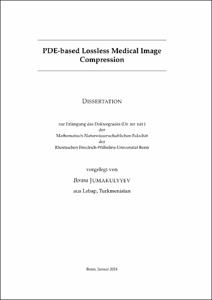Jumakulyyev, Ikram: PDE-based Lossless Medical Image Compression. - Bonn, 2024. - Dissertation, Rheinische Friedrich-Wilhelms-Universität Bonn.
Online-Ausgabe in bonndoc: https://nbn-resolving.org/urn:nbn:de:hbz:5-76924
Online-Ausgabe in bonndoc: https://nbn-resolving.org/urn:nbn:de:hbz:5-76924
@phdthesis{handle:20.500.11811/11649,
urn: https://nbn-resolving.org/urn:nbn:de:hbz:5-76924,
author = {{Ikram Jumakulyyev}},
title = {PDE-based Lossless Medical Image Compression},
school = {Rheinische Friedrich-Wilhelms-Universität Bonn},
year = 2024,
month = jul,
note = {In this dissertation, our scientific goal is to investigate the potential of Partial Differential Equations (PDEs) for designing a lossless medical image compression codec.
The dissertation consists mainly of three of our contributions that build upon each other. In our first work, we designed PDEs that give better reconstruction than state-of-the-art Edge-enhancing diffusion (EED), especially in a very sparse subset of pixels. In this work, we generalize second-order EED to a fourth-order counterpart. It involves a fourth-order diffusion tensor that is constructed from the regularized image gradient in a similar way as in traditional second-order EED, permitting diffusion along edges, while applying a non-linear diffusivity function across them.
We show that our fourth-order diffusion tensor formalism provides a unifying framework for all previous anisotropic fourth-order diffusion-based methods and that it provides additional flexibility. We achieve an efficient implementation using a fast semi-iterative scheme. Experimental results on natural and medical images suggest that our novel fourth-order method produces more accurate reconstructions compared to the existing second-order EED.
In our second work, we introduce a PDE-based codec that achieves competitive compression rates for lossless image compression. It is based on coding the differences between the original image and its PDE-based reconstruction. These differences often have lower entropy than the original image, and can therefore be coded more efficiently. We optimize this idea via an iterative reconstruction scheme, and a separate coding of empty space, which takes up a considerable fraction of the field of view in many 3D medical images. We demonstrate that our PDE-based codec compares favorably to previously established lossless codecs. We also investigate the individual benefit from each ingredient of our codec on multiple examples, explore the effect of using homogeneous, edge-enhancing, and fourth-order anisotropic diffusion, and discuss the choice of contrast parameters.
For our last work, we introduce a novel lossless codec for diffusion MRI data. Diffusion MRI generates huge amounts of data, resulting from a large number of repeated 3D scans. Each volume samples a location in q-space, indicating the direction and strength of a diffusion-sensitizing gradient during the measurement. Our codec reduces file sizes by more than 30% compared to GZIP, and also beats lossless codecs from the JPEG family. It builds on our previous work on lossless PDE-based compression of 3D medical images, but additionally exploits smoothness in q-space. We demonstrate that, compared to using only image space PDEs, q-space PDEs further improve compression rates. Moreover, implementing them with Finite Element Methods and a custom acceleration significantly reduces computational expense.
Finally, we show that our codec clearly benefits from integrating subject motion correction, and slightly from optimizing the order in which the 3D volumes are coded.},
url = {https://hdl.handle.net/20.500.11811/11649}
}
urn: https://nbn-resolving.org/urn:nbn:de:hbz:5-76924,
author = {{Ikram Jumakulyyev}},
title = {PDE-based Lossless Medical Image Compression},
school = {Rheinische Friedrich-Wilhelms-Universität Bonn},
year = 2024,
month = jul,
note = {In this dissertation, our scientific goal is to investigate the potential of Partial Differential Equations (PDEs) for designing a lossless medical image compression codec.
The dissertation consists mainly of three of our contributions that build upon each other. In our first work, we designed PDEs that give better reconstruction than state-of-the-art Edge-enhancing diffusion (EED), especially in a very sparse subset of pixels. In this work, we generalize second-order EED to a fourth-order counterpart. It involves a fourth-order diffusion tensor that is constructed from the regularized image gradient in a similar way as in traditional second-order EED, permitting diffusion along edges, while applying a non-linear diffusivity function across them.
We show that our fourth-order diffusion tensor formalism provides a unifying framework for all previous anisotropic fourth-order diffusion-based methods and that it provides additional flexibility. We achieve an efficient implementation using a fast semi-iterative scheme. Experimental results on natural and medical images suggest that our novel fourth-order method produces more accurate reconstructions compared to the existing second-order EED.
In our second work, we introduce a PDE-based codec that achieves competitive compression rates for lossless image compression. It is based on coding the differences between the original image and its PDE-based reconstruction. These differences often have lower entropy than the original image, and can therefore be coded more efficiently. We optimize this idea via an iterative reconstruction scheme, and a separate coding of empty space, which takes up a considerable fraction of the field of view in many 3D medical images. We demonstrate that our PDE-based codec compares favorably to previously established lossless codecs. We also investigate the individual benefit from each ingredient of our codec on multiple examples, explore the effect of using homogeneous, edge-enhancing, and fourth-order anisotropic diffusion, and discuss the choice of contrast parameters.
For our last work, we introduce a novel lossless codec for diffusion MRI data. Diffusion MRI generates huge amounts of data, resulting from a large number of repeated 3D scans. Each volume samples a location in q-space, indicating the direction and strength of a diffusion-sensitizing gradient during the measurement. Our codec reduces file sizes by more than 30% compared to GZIP, and also beats lossless codecs from the JPEG family. It builds on our previous work on lossless PDE-based compression of 3D medical images, but additionally exploits smoothness in q-space. We demonstrate that, compared to using only image space PDEs, q-space PDEs further improve compression rates. Moreover, implementing them with Finite Element Methods and a custom acceleration significantly reduces computational expense.
Finally, we show that our codec clearly benefits from integrating subject motion correction, and slightly from optimizing the order in which the 3D volumes are coded.},
url = {https://hdl.handle.net/20.500.11811/11649}
}






